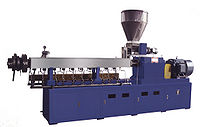Extruders
Extruders are used to create a wide range of items, including plastic tubing, trims, seals, plastic sheets and rods. Extruder is the machine for producing more or less continuous lengths of plastic sections out of a selected type of plastic resin. There are a number of extrusion techniques available such as co-extrusion, offset extrusion, oriented extrusion, overcoat extrusion, cold extrusion, ram extrusion and much more.
The essential elements for a thermoplastic extruder are a tubular barrel, usually electrically heated; a revolving screw, ram or plunger within the barrel; a hopper at one end from which the material to be extruded is fed to the screw, ram or plunger; a die at the opposite end for shaping the extruded mass.
Common Types
Extruders may be divided into three general types:
Single Screw Extruder
Single screw extruders are the most widely used extruders. The screw that is used to push the resin out of the die is the important component of a screw extruder. In the earlier days rubber screw were used but the rubber screw was not able to give enough amount of shear into the polymer. Therefore, screws were designed that would start deeper in the feed and gradually taper shallower in the metering section to apply more work on the polymer as it was going from the feed to the discharge.
Twin or Multiple Screw Extruder
The screw is usually contained inside a tight fitting barrel driven by a variable speed motor and gearbox. It is a highly efficient device capable of processing several tons of plastic per hour, even in modestly sized extruders. The screw is divided into three division the feed section, the compressor and the metering section.
Ram Extruder
The resin is sometimes not completely melted in the basic extrusion screw. The barrier screw in designed to counter this problem. Additional flights are attached to the transition section so as to separate molten and solid plastic to different channels. As the solid pellet moves forward it melts due to shear against the wall and thus melts and flows into the liquid channel. Thus the solid channel narrow gradually and the liquid channel widens.
Video
